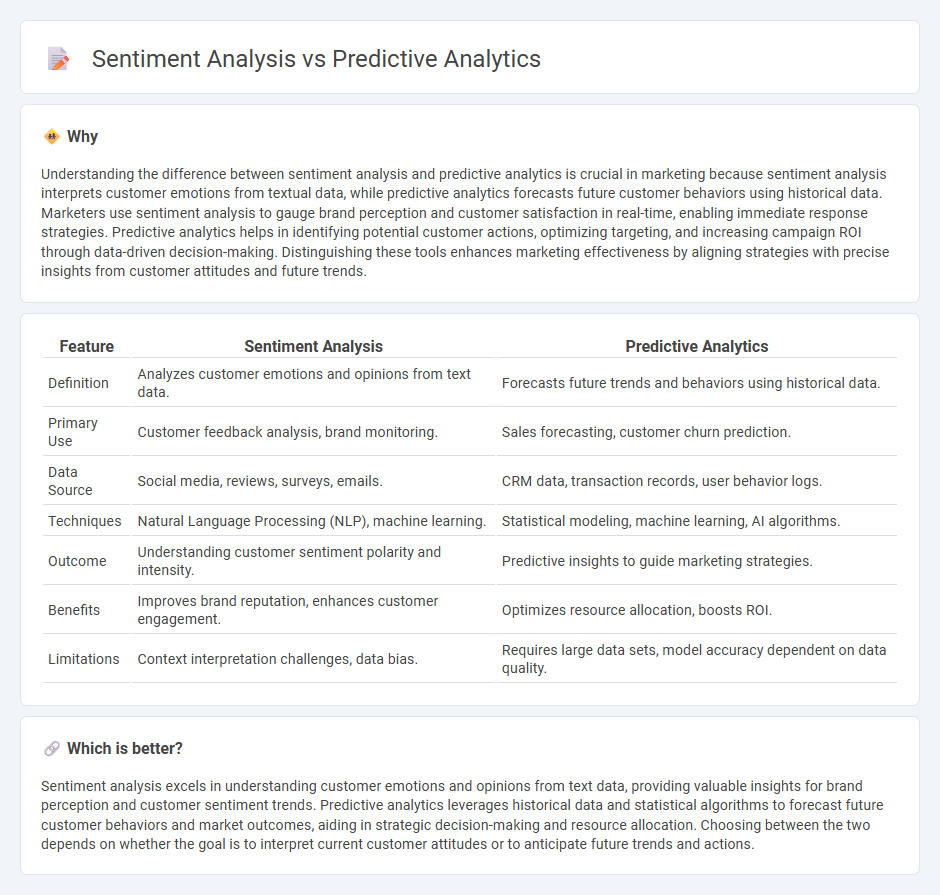
Sentiment analysis focuses on interpreting customer emotions and opinions from textual data, enabling brands to gauge public perception and improve engagement strategies. Predictive analytics uses historical data and statistical algorithms to forecast future consumer behaviors and market trends, driving informed business decisions. Discover how integrating these powerful tools can transform marketing strategies and boost ROI.
Why it is important
Understanding the difference between sentiment analysis and predictive analytics is crucial in marketing because sentiment analysis interprets customer emotions from textual data, while predictive analytics forecasts future customer behaviors using historical data. Marketers use sentiment analysis to gauge brand perception and customer satisfaction in real-time, enabling immediate response strategies. Predictive analytics helps in identifying potential customer actions, optimizing targeting, and increasing campaign ROI through data-driven decision-making. Distinguishing these tools enhances marketing effectiveness by aligning strategies with precise insights from customer attitudes and future trends.
Comparison Table
| Feature | Sentiment Analysis | Predictive Analytics |
|---|---|---|
| Definition | Analyzes customer emotions and opinions from text data. | Forecasts future trends and behaviors using historical data. |
| Primary Use | Customer feedback analysis, brand monitoring. | Sales forecasting, customer churn prediction. |
| Data Source | Social media, reviews, surveys, emails. | CRM data, transaction records, user behavior logs. |
| Techniques | Natural Language Processing (NLP), machine learning. | Statistical modeling, machine learning, AI algorithms. |
| Outcome | Understanding customer sentiment polarity and intensity. | Predictive insights to guide marketing strategies. |
| Benefits | Improves brand reputation, enhances customer engagement. | Optimizes resource allocation, boosts ROI. |
| Limitations | Context interpretation challenges, data bias. | Requires large data sets, model accuracy dependent on data quality. |
Which is better?
Sentiment analysis excels in understanding customer emotions and opinions from text data, providing valuable insights for brand perception and customer sentiment trends. Predictive analytics leverages historical data and statistical algorithms to forecast future customer behaviors and market outcomes, aiding in strategic decision-making and resource allocation. Choosing between the two depends on whether the goal is to interpret current customer attitudes or to anticipate future trends and actions.
Connection
Sentiment analysis extracts valuable insights from customer opinions by analyzing text data, which feeds predictive analytics models to forecast consumer behavior and market trends accurately. Integrating sentiment scores into predictive algorithms enhances the ability to identify potential opportunities and risks, improving campaign targeting and ROI. This synergy enables marketers to make data-driven decisions, optimizing strategies based on real-time consumer emotions and predicted outcomes.
Key Terms
Predictive Analytics:
Predictive analytics leverages historical data, statistical algorithms, and machine learning techniques to forecast future outcomes and trends, enhancing decision-making in industries like finance, healthcare, and marketing. It processes structured and unstructured data to identify patterns, predict customer behavior, optimize operations, and manage risks effectively. Explore the power of predictive analytics to transform raw data into strategic business insights.
Forecasting
Predictive analytics utilizes historical data and statistical algorithms to forecast future trends, customer behaviors, and business outcomes with high accuracy. Sentiment analysis, a subset of text analytics, focuses on interpreting and classifying emotions within textual data but is less suited for long-term forecasting beyond customer opinions and market sentiment. Explore detailed comparisons to understand the strengths and applications of both techniques in forecasting.
Data Modeling
Predictive analytics leverages historical data and statistical models to forecast future outcomes, employing techniques such as regression, decision trees, and machine learning algorithms to identify patterns and trends. Sentiment analysis involves natural language processing (NLP) and text mining to interpret and classify emotions or opinions expressed in data, primarily focusing on unstructured text sources like social media, reviews, and customer feedback. Explore the nuances of data modeling in these fields to understand how structured and unstructured data are transformed into actionable insights.
Source and External Links
What is Predictive Analytics? | IBM - Predictive analytics uses historical data combined with statistical modeling, data mining, and machine learning to predict future outcomes by identifying patterns, trends, and risks in data.
What is predictive analytics and how does it work? | Google Cloud - Predictive analytics forecasts future outcomes using data analysis, machine learning, artificial intelligence, and statistical models, often classifying or predicting continuous variables based on historical and current data.
A Guide To Predictive Analytics | Tableau - Predictive analytics helps organizations anticipate future events by using data mining, statistics, AI, and machine learning to discover patterns and inform proactive decision-making.
 dowidth.com
dowidth.com